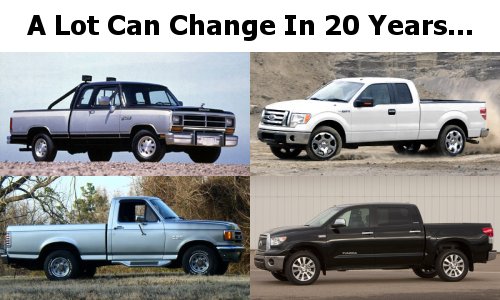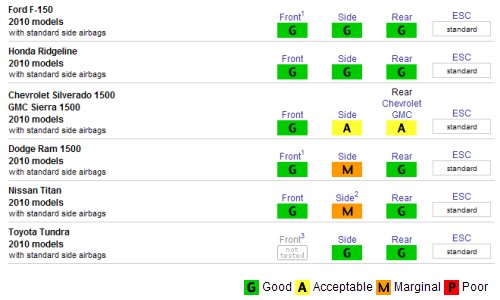Truck Safety Then And Now – 1990 vs 2010
Jason Lancaster | Jan 22, 2010 | Comments 6
Pickup trucks have evolved quite a bit in the last 20 years. In 1990, fuel injection and automatic locking hubs were “new” technology, most trucks were available with manual transmissions, and the most powerful engine in a half-ton was Chevy’s 454 V8 with 255 hp. Safety standards have changed a lot too – a 1990 Toyota pickup had just a one-star safety rating in a driver’s side frontal-impact test (yikes!).

Trucks have changed a lot in the last 20 years
Pickup truck safety, along with fuel economy and performance, has improved a LOT since 1990. The 2010 Tundra DoubleCab and CrewMax trucks have a 5 star National Highway Transportation Safety Administration (NHTSA) crash test rating. 2010 Tundras also have brake assist; anti-lock disc brakes; stability control; traction control; electronic brake force distribution; and all the standard front-seat side full-length curtain side airbags, plus new front-seat knee airbags. In 1990, most of these safety technologies were considered “cutting edge.”
Unfortunately, some of these technologies – like electronic stability control and side airbags – were still considered “cutting edge” until just this year. Chevy, GMC, and Nissan didn’t make side airbags or stability control standard until 2010…despite their well-documented safety benefits.

A nice explanation of the benefits of electronic stability control
Of course, when you talk about safety, you can’t just talk about government crash tests. In addition to a 5 star crash test rating from NHTSA, the 2010 Tundra has also earned the highest possible rating of “good” during side- and rear-impact crash testing conducted by the Insurance Institute for Highway Safety (IIHS). In fact, the Tundra holds the honor of being the first ever full-size pickup to earn the IIHS’s Top Safety Pick award back in 2007.
However, the really good news is that the Tundra isn’t alone in terms of being safe. Trucks from every major manufacturer also enjoy solid safety ratings, with most trucks having government crash test ratings of 4 or better. The IIHS rates most 2010 model trucks as “Good” in front and rear impacts, with only a couple of trucks rating “Marginal” in side impacts.

IIHS crash test ratings for 2010 full-size pickups
As a result of all of these safety advances, you can get cheaper car insurance for a new vehicle than you could have ever had before (adjusted for inflation, of course). Car insurance rates are largely set by the risk of personal injury, so safer vehicles tend to have lower rates. Isn’t technology grand?
Search terms people used to find this page:
- https://tundraheadquarters com/truck-safety-then-and-now-1990-vs-2010/
Filed Under: Auto News


Agree with everything said except the fuel economy improving A LOT. Actually, while perfomance numbers have gone up considerably, the fuel mileage increase only 1-3 more mpg than 1990. My first new truck was in 1990 or 1991 (can’t remember) and it was a chevy extended cab with a 350 motor 5.7L. I consistently got day in and day out same driving as today same roads, etc. 16 mph mixed driving. Today a new chevy gets about 18 mpg avg. driving same conditions with the new 5.3L V8 and the new 5.7L tundra I get about 17 mpg avg. mixed driving. If people did not demand 381 hp and 401 lbs. of torque and got by with I think at the time in 1991 with 350 5.7L chevy about 295 hp/315 torque (I think – it has been awhile) of which pulled very well with no problems back then, just not as fast off the line as the newer tundras. Could you imagine what gas mileage numbers could be now in 2010 if the mfgs. cut hp/torque ratings to that 300 range which is really fine to pull anything a 1/2 ton can pull? It would and should be in the low 20’s mpg for sure if you ask me by now in 2010. Back in 1991, chevy silverados were rated at 13/17 4wd and low and behold the new tundras are rated at 13/17 in 4wd also today 20 years later. Not much gain in mpg if you ask me, just performance numbers.
mk – I hear what you’re saying, but I don’t know that cutting power on these new trucks would boost fuel economy too much. Part of the change between 1990 and 2010 is that all vehicles have gotten heavier. A 1990 Regular Cab F150 weighed about 3,900 lbs, where the 2010 Regular Cab F150 weighs about 4,700 lbs. That’s an increase of more than 20%. The fact that trucks are 50% – 100% more powerful these days if offset by the fact that they way 20-25% more than they used too.
Most of this weight is related to safety, emissions, sound deadening, and overall improved quality (thicker frames, bigger and better powertrains, etc.). Some of it is legally mandated, and some of it is that many consumers expect trucks to ride and drive like cars.
Still, you’re 100% correct: if a truck manufacturer built a simple, light-weight truck that was designed to be efficient, they could get great fuel economy. Check this out:
https://www.tundraheadquarters.com/blog/2009/08/03/mahindra-markets-value-priced-diesel-power/
Mahindra claims 25+ mpg with a 2,000 lbs payload rating for less than 30k. They’re doing it with a diesel, but you get the idea. The question is, will consumers buy a bare-bones pickup, or will they trade some efficiency for some creature comforts? My guess? The market for a small, efficient pickup that trades performance for fuel efficiency is small. Consumers want it all.
I did a little research and you are correct to my amazement that full size 1/2 ton trucks are getting heavier. I thought they would be getting lighter since the sheet metal and components are turning to plastic instead of heavier gauge sheet metal, but I was wrong to my amazement yet again. The tundra is not a good example since the 2007 tundra was toyota’s first, in my opinion, full size 1/2 ton truck. However, I compared 1990 to 2009 chevy weights and you are correct since both are full sized trucks and the 2009 weighs more than the 1990 chevy even though the sheet metal is thinner and more plastic parts on 2009 truck. Why can’t we have both? performance to a lesser matter say 310 hp and 335 torque which is quick enough and fuel mileage into the low 20’s? Don’t tell me it cannot be done because it can.
mk – Crazy isn’t it? The auto manufacturers blame the federal government…they say that all the mandated safety and emissions gear (mostly safety) makes vehicles much heavier than they need to be. I’m not so sure.
I think the reality is that it’s cheaper to build them heavy. Steel is cheaper than aluminum, and plastic is more expensive than both. One of the ways that manufacturers will improve fuel economy going forward is to cut down weight. Plastic pickup beds are just around the corner I think, and I wouldn’t be surprised if we see carbon-fiber more commonly integrated into frames (probably just on passenger cars, but who knows). There’s also talk of “nano plastics” coming out very soon that are just as strong as regular plastic but only 1/3rd the thickness. These could be used for trim pieces and cut down on weight considerably. The list goes on and on…
To sum up – you are correct. It CAN be done…hopefully it will be when people start to focus on weight. Weight, after all, is the biggest enemy of fuel economy.
Have you ever considered that the fuel in the 90s is also different from the fuel being used today? Just a thought…..
I recently had a scary experience in my 2007 Toyota Tundra and need to know if anyone else out there has had the same thing happen. I recently took my Tundra through a car wash, as I went through the wash my vehicle was in neutral, with the engine running. As I was near the end I was watching the yellow flashing light. At the end of the wash the light turned green and I put my truck into drive. At that time my pick-up had a tremendous acceleration, I at no time had my foot on the accelerator. I put my right foot on the brake pedal & I had no, I repeat no brakes!! I hit a 3ft. brick wall, the truck veered to the left where it finally stopped. No airbag’s went off.. The truck was laying at such a angle I was lucky it didn’t go over on it’s left side.. Right now the truck is sitting at the Toyota dealership waiting to have it inspected and all the info pulled from the computer.. The damage so far is $3294.but the estimator told me it could run higher as they start repairing the damage.. This happened on 9/23/2011, I bought the truck brand new in 2007 from a Toyota Dealer, have had it 4 years and put only 21,000 miles on it. Just makes me sick!! BPK